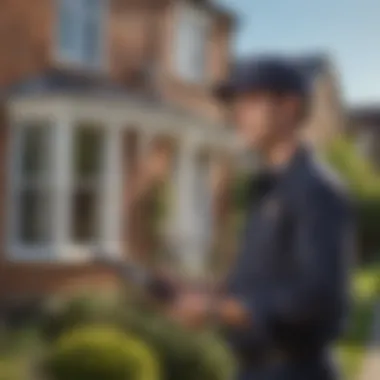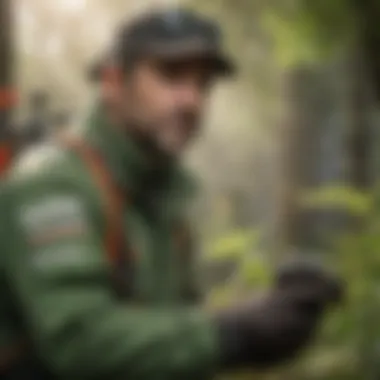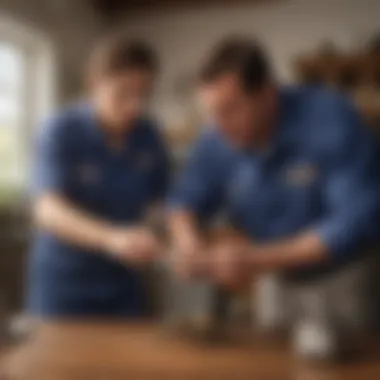Unveiling the Crucial Role of Pest Control Service Technicians in Public Health and Safety Preservation


Preventive Pest Control Strategies
When it comes to maintaining a pest-free environment in your home, employing preventive pest control strategies is crucial. One of the primary areas to focus on is House Exterior Protection. By implementing tips for sealing cracks and crevices, clearing debris, and preventing pests from entering, you can create a strong first line of defense against infestations.
Yard Maintenance plays a significant role in pest prevention as well. Regularly engage in essential yard care routines such as mowing the lawn, trimming shrubs, and removing standing water to deter pests from making your outdoor space their home. Additionally, adopt methods like planting pest-repelling plants and using organic yard treatments to keep your yard pest-free.
Indoor Cleanliness is another key aspect to consider. Implement expert cleaning tips and techniques to maintain a pest-resistant indoor environment. Regularly vacuuming, decluttering, and storing food in airtight containers are simple yet effective ways to prevent pests from taking up residence in your home.
Proper Garbage Disposal is essential in preventing pest attractions. Utilize efficient waste disposal methods such as sealing trash bags tightly, disposing of food waste promptly, and maintaining clean garbage bins. Proper garbage disposal not only keeps your home clean but also reduces the likelihood of pest infestations.
In addition to these core strategies, exploring Other Pest Prevention Strategies can further fortify your pest control efforts. Innovative methods like using mesh screens on windows, installing door sweeps, and employing ultrasonic pest repellents can provide additional layers of protection for your home.
Introduction
In this article, we delve into the pivotal role that pest control service technicians play in ensuring public health and safety. Pest infestations pose significant risks to both hygiene and well-being, making the expertise of these professionals invaluable. By intricately examining the responsibilities, skills, and challenges encountered by pest control technicians, we aim to enlighten readers about the essential contributions made in managing and eradicating pests. This exploration will shed light on how these experts safeguard environments from disease transmission and maintain standards of cleanliness.
Throughout this piece, we will dissect the multifaceted nature of pest control operations, emphasizing the crucial link between pest management and public health. By elucidating the intricate processes involved in pest control, readers will gain a profound understanding of the meticulous work and expertise required to combat infestations effectively. The meticulousness and attention to detail exhibited by these technicians are paramount in ensuring a safe and healthy living environment for all individuals.
Understanding the intricacies of pest control is essential for appreciating the comprehensive approach taken by technicians in tackling infestations. This article will serve as a guide to the various facets of pest control services, illustrating the intricate web of considerations that technicians navigate when devising treatment plans and executing control measures. Stay tuned as we uncover the behind-the-scenes efforts of pest control technicians in safeguarding public health and safety!
The Importance of Pest Control
Pest control plays a crucial role in maintaining public health and safety, making it a topic of significant importance. By effectively managing pest infestations, pest control technicians contribute to creating healthy environments for communities. The significance lies in preventing the proliferation of disease-carrying pests such as rodents, insects, and other vermin that pose serious health risks to humans. Additionally, pest control helps in safeguarding property structures from structural damage caused by pests. Ensuring proper pest control measures not only protects individuals from health hazards but also preserves the integrity of buildings and infrastructure.
Understanding Pest Infestations
Understanding pest infestations is fundamental for pest control technicians to develop efficient strategies. Pest infestations occur when pests multiply rapidly in a particular area, causing disturbances and health hazards. Various factors contribute to infestations, including favorable environmental conditions, food sources, and breeding grounds for pests. By comprehending the behavior and habits of different pests, technicians can identify infestation patterns and select appropriate control methods to address the issue effectively.


Impact on Public Health
Pest infestations have a direct impact on public health by serving as vectors for diseases. Pests such as mosquitoes, flies, and rodents can transmit various illnesses, including malaria, dengue fever, and leptospirosis. Moreover, pest allergens and toxins released by pests can trigger allergic reactions and respiratory problems in individuals, especially vulnerable populations such as children and the elderly. By managing pest infestations, pest control technicians help mitigate these health risks, contributing to the overall well-being and safety of communities.
Role of a Pest Control Service Technician
A Pest Control Service Technician plays a pivotal role in ensuring public health and safety by effectively managing and controlling pest infestations. Their expertise and meticulous approach are crucial in maintaining hygienic environments and preventing the spread of diseases. These professionals possess a diverse set of responsibilities, ranging from inspection and assessment to developing treatment plans and educating customers on pest prevention methods. Their knowledge of pest behavior and control measures is essential for mitigating potential health risks associated with infestations.
Inspection and Assessment
Initial Assessment
The initial assessment conducted by a Pest Control Service Technician is a fundamental step in understanding the scope and severity of a pest infestation. By thoroughly examining the affected area, identifying possible entry points, and assessing pest activity, technicians can formulate an effective treatment strategy. This process allows them to tailor their approach to the specific needs of the situation, ensuring efficient and targeted pest control measures. The initial assessment serves as a baseline for subsequent actions, guiding technicians in their efforts to eradicate pests and prevent future infestations.
Identification of Pest Species
Identifying the species responsible for the infestation is crucial for determining the most appropriate control methods. Pest Control Service Technicians use their knowledge of entomology and pest behavior to accurately diagnose the problem. By recognizing the unique characteristics and habits of different pest species, technicians can devise tailored strategies to eliminate them effectively. This personalized approach enhances the efficiency of pest management efforts, minimizing the use of unnecessary pesticides and reducing environmental impact.
Assessment of Infestation Severity
Assessing the severity of the infestation is vital in identifying the extent of the problem and implementing targeted control measures. Pest Control Service Technicians evaluate factors such as population size, breeding areas, and damage caused by pests to gauge the severity of the situation. This detailed assessment enables technicians to prioritize treatment areas, allocate resources efficiently, and monitor the effectiveness of their interventions. By understanding the level of infestation severity, technicians can calibrate their efforts to achieve optimal results while minimizing disruption to the surrounding environment.
Developing Treatment Plans
Selection of Control Methods
The selection of control methods is a critical aspect of developing an effective treatment plan. Pest Control Service Technicians assess various factors, including pest species, infestation severity, environmental considerations, and client preferences, to choose the most suitable control measures. Whether opting for chemical, biological, or physical control methods, technicians prioritize safety, efficacy, and sustainability in their decision-making process. By selecting appropriate control methods, technicians can effectively combat pests while safeguarding public health and the environment.
Implementation of Preventive Measures


Implementing preventive measures is essential for long-term pest management and minimizing the risk of future infestations. Pest Control Service Technicians employ a proactive approach, focusing on pest exclusion, habitat modification, and sanitation practices to prevent pest resurgence. By addressing underlying causes of infestations and creating inhospitable conditions for pests, technicians help clients maintain pest-free environments. Client Consultation
Client Consultation
Client consultation plays a crucial role in developing sustainable pest management strategies. Pest Control Service Technicians engage with clients to understand their concerns, assess their expectations, and provide personalized recommendations for pest control. Effective communication ensures that clients are informed about treatment options, involved in decision-making processes, and empowered to participate in pest prevention efforts. By fostering open dialogue and building rapport with clients, technicians contribute to successful outcomes and long-term pest control solutions.
Application of Pest Control Measures
Safe Handling of Chemicals
Safe handling of chemicals is paramount in pest control to protect human health and the environment. Pest Control Service Technicians undergo extensive training to ensure proper handling, storage, and disposal of pesticides. By adhering to safety protocols, using personal protective equipment, and following regulatory guidelines, technicians minimize the risks associated with chemical applications. Prioritizing safety not only safeguards the well-being of technicians but also upholds ethical standards in pest management practices.
Use of Integrated Pest Management
Integrated Pest Management (IPM) is a holistic approach that Pest Control Service Technicians adopt to address pest problems effectively. By combining multiple control strategies, such as biological control, habitat modification, and monitoring, technicians create sustainable and environmentally friendly solutions. IPM emphasizes proactive prevention, minimal pesticide use, and regular evaluation of pest populations to ensure long-term effectiveness. This comprehensive approach enhances pest control outcomes while reducing reliance on chemical interventions.
Monitoring and Evaluation
Monitoring and evaluation are integral components of pest control programs to assess the progress and effectiveness of treatment plans. Pest Control Service Technicians systematically track pest populations, observe changes in behavior, and evaluate the impact of control measures over time. This ongoing monitoring allows technicians to make data-driven decisions, adjust control strategies as needed, and demonstrate the outcomes of their interventions to clients. By continuously monitoring and evaluating pest control measures, technicians ensure the sustainability and success of pest management initiatives.
Customer Education and Awareness
Customer education and awareness are key elements of a Pest Control Service Technician's role in empowering clients to prevent future pest issues. Technicians educate customers on pest biology, identification, and prevention methods to foster a proactive approach to pest control. By raising awareness about potential risks, implementing preventive measures, and encouraging collaboration with clients, technicians empower individuals to maintain pest-free environments and protect public health. Effective customer education builds trust, enhances communication, and cultivates a sense of shared responsibility in creating healthy living spaces.
Challenges Faced by Pest Control Technicians
Pest control technicians face a myriad of challenges in their line of work, each crucial to highlight for a deeper understanding of the complexities involved in ensuring public health and safety. By delving into these challenges, we can appreciate the meticulous care and expertise required in addressing pest infestations effectively.


Safety Risks and Regulations
Safety is paramount in pest control operations, with technicians constantly navigating potential risks inherent in handling chemicals and deploying control measures. From exposure to toxic substances to the physical dangers posed by climbing ladders or accessing confined spaces, technicians must adhere to stringent safety protocols to protect themselves and the general public. Furthermore, staying abreast of ever-evolving regulations is essential to ensure compliance with industry standards and safeguard environmental and human well-being.
Environmental Concerns
Beyond the immediate task of pest eradication, technicians must grapple with the broader environmental implications of their work. Balancing the need for effective pest management with eco-conscious practices presents a nuanced challenge, where minimizing harm to non-target species and ecosystems is paramount. Implementing strategies that are both effective against pests and environmentally sustainable demands a deep understanding of ecological systems and a commitment to practicing responsible pest control techniques.
Client Communication and Expectations
Effective communication is a cornerstone of successful pest control service delivery, yet navigating client expectations and concerns can be intricate. Technicians must possess not only technical expertise but also interpersonal skills to address client queries, allay fears, and manage expectations regarding treatment outcomes. Clear and transparent communication about the treatment process, potential challenges, and post-treatment care is essential to fostering trust and ensuring client satisfaction.
Emerging Trends in Pest Control Services
In the realm of pest control services, staying abreast of emerging trends is paramount to ensure effective and sustainable pest management solutions. The ongoing evolution of pest control methods and practices is fueled by the need for more environmentally-friendly and efficient approaches to pest eradication. Understanding the significance of incorporating these emerging trends is crucial in enhancing public health and safety.
Sustainability Practices
Sustainability practices in pest control involve the utilization of eco-friendly and non-toxic methods to combat pests while minimizing harm to the environment. Integrated Pest Management (IPM) techniques are at the forefront of sustainable practices, emphasizing prevention, monitoring, and control through a holistic approach that reduces reliance on chemical interventions. By promoting ecosystem health and biodiversity, sustainability practices not only target pests but also safeguard beneficial organisms and promote long-term pest management solutions.
Technological Advancements
Technological advancements have revolutionized the field of pest control, offering innovative tools and solutions to enhance efficiency and efficacy. From state-of-the-art pest monitoring systems to automated treatment applications, technology has streamlined processes and provided real-time insights for precise pest management. Advances such as drones for aerial surveillance, smart traps, and remote sensors have enabled technicians to gain a deeper understanding of pest behaviors and infestation patterns, facilitating targeted interventions and optimizing resource allocation.
Data-Driven Approaches
Data-driven approaches in pest control rely on the analysis of comprehensive data sets to drive informed decision-making and strategic planning. By harnessing data analytics and mapping technologies, pest control technicians can identify high-risk areas, predict pest outbreaks, and implement proactive measures to mitigate infestations effectively. Leveraging data allows for strategic intervention strategies, resource optimization, and continuous improvement in pest management practices, ultimately bolstering public health outcomes and ensuring long-term sustainability.
Conclusion
In delving deep into the pivotal topic of pest control service technicians and their role in ensuring public health and safety, it becomes evident that their contribution is nothing short of indispensable. The threads of inspection, assessment, treatment planning, application of measures, and customer education intricately weave together to form a comprehensive tapestry of pest management expertise. Each step in that process is meticulously crafted to tackle pest infestations head-on, safeguarding not only properties but also safeguarding the health and well-being of individuals.
Moreover, the diligent work of these technicians goes beyond mere pest eradication; it extends towards the prevention of diseases that thriving pests can carry and spread. This preventive aspect is a cornerstone in the foundation of public health initiatives, highlighting the proactive nature of pest control services in averting potential health crises. The vigilance exercised by these professionals in keeping environments hygienic and disease-free cannot be overstated.
Furthermore, the integration of sustainability practices, usage of technological advancements, and adoption of data-driven approaches infuse a sense of innovation and efficiency into the traditional field of pest control. These emerging trends not only enhance the efficacy of pest management but also underline the adaptability and forward-thinking nature of the industry.



